
Coffee culture
With over 400 billion cups consumed each year, coffee is one of the most popular beverages worldwide. Its popularity is probably a result of both its taste and the stimulating effect of caffeine. Women have indicated they drink coffee to relax; men say that drinking coffee helps them get their work done.
Of course, coffee has a social aspect too. People head to coffeehouses or cafs to sit down and enjoy their favourite coffee. All of us go out with friends and “drink coffee” – it’s just what we do! Whether we actually order coffee or hot chocolate or tea, coffee is still the primary reason we go out. It both relaxes us and stimulates good conversation.
Walking down the main street of town you’ll see hundreds of people – from rushing businessmen to punks wearing headphones, from hard-working construction men to little old ladies sitting at the sidewalk caf – all sipping from their favourite brand. Everyone on TV drinks it; you always hear somebody on Shortland Street ordering a flat white. And it’s only natural for us to follow the trends (that’s what fashion’s all about). As my flatmate once profoundly told me, “It’s the drink people drink.”
It was only recently that I became passionate about coffee. As a marketing student as well as a barista, I can see what a huge consumer demand there is for a good (actually an excellent) cup of coffee. There are many intricate factors involved in mastering the art of coffee preparation, but the satisfaction I get from creating the perfect cup for a customer puts a smile on my face. And being complimented afterwards for making the best coffee in town just makes my day.
When I refer to making coffee, I’m not talking about thick, black, burnt coffee that most Americans drink (also known as filtered coffee). I’m talking about lattes, flat whites, cappuccinos and mochas – types of coffee made with a shot of espresso. New Zealanders are world leaders in their taste for espresso coffee. In the last three years, Kiwi baristas have reached the top ten in the World Barista Championship. Considering we’re competing against countries such as Italy and the Arabic countries (where the coffee bean was first cultivated), that’s a huge achievement.
Last month, I entered the regional barista competition – and in what better place than fashionable Wellington? It was a great learning experience. I was involved in the culture of coffee. I talked to other baristas about coffee blends, about adding flavours to match the espresso taste, and about artistic designs to make elegant lattes.
The first step in the coffee-making process is the beans: a coffee distributor will pick, roast, blend and then package them to perfection. “Blending” is what defines different coffee brands such as Robert Harris or Starbucks. It combines the different kinds of coffee beans: sweet, acidic and caramelised, or strong, rich, full-bodied flavours. The taste of a good blend will affect all parts of your tongue, and it should be quite naturally sweet, as the roasting brings out natural sugars.
But it’s really the barista’s job that is most important in the whole process. When I prepare the perfect shot of espresso, the ground coffee has to be fresh (as a customer, you can ensure this by listening for the grinder running before your coffee is made). The ground coffee has to have a good consistency – not too fine but also not too coarse. Often I have to change the grind five times a day as temperature and humidity affect the grinding. The ground coffee then gets packed tightly and evenly into the dispenser.
The extraction of the coffee is also vital. A double shot runs for between 25 to 30 seconds and produces 60 mL of thick, dark, creamy coffee – this is the espresso, the base for any of your favourite drinks.
Steaming the milk (for a latte) requires two steady hands. One to hold the handle of the jug and adjust the steam wand to the depth of the milk, the other to hold the bottom of the jug to ensure a perfect temperature. There is nothing worse than a lukewarm or burnt latte to ruin the espresso shot. Milk froth also varies with the different coffee types.
Keeping all this in mind will produce an excellent coffee. The future of coffee depends on baristas to be professional, consistent and passionate about their jobs. Customers, tell the barista exactly how you want your coffee. It’s our job to listen.
Today, coffee is as popular as ever. New studies always come up, telling us of the health benefits or risks of drinking it. I just ignore them (as do the majority of the world). Coffee is delicious and stimulating – what more could you want?
Monique Kloeg makes coffee by day, pours beer by night, socialises with the locals of Masterton, and, of course, wants world peace.

